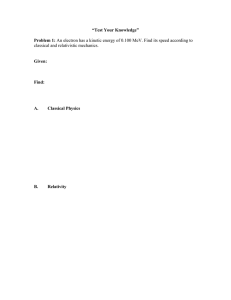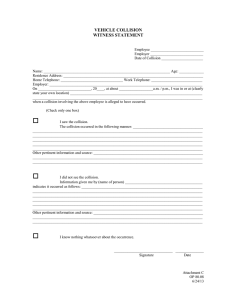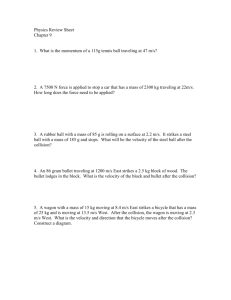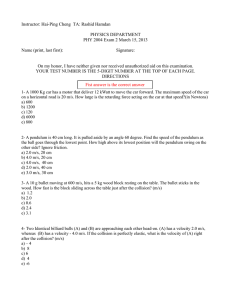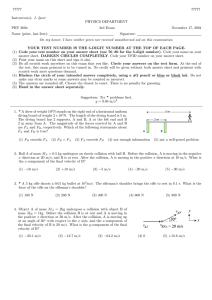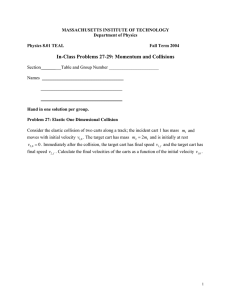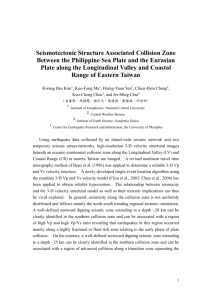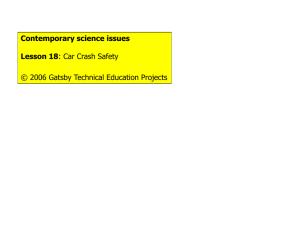Phys.2211 review guide
advertisement
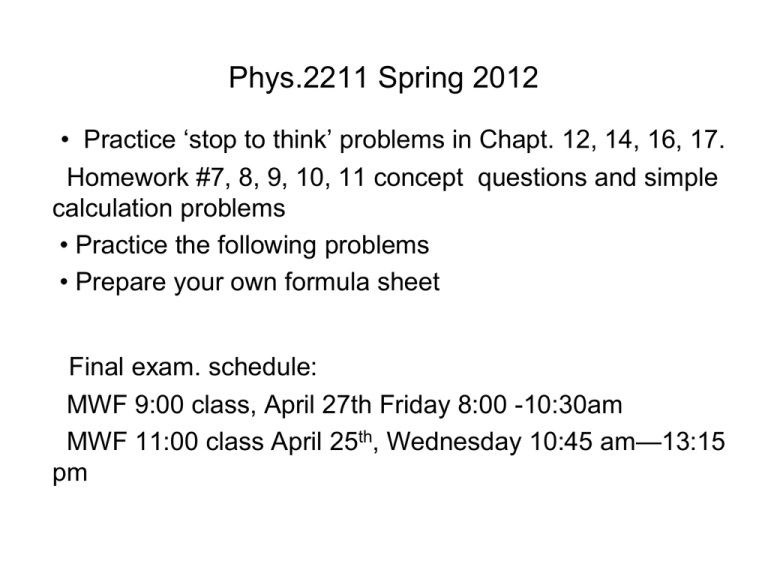
Phys.2211 Spring 2012 • Practice ‘stop to think’ problems in Chapt. 12, 14, 16, 17. Homework #7, 8, 9, 10, 11 concept questions and simple calculation problems • Practice the following problems • Prepare your own formula sheet Final exam. schedule: MWF 9:00 class, April 27th Friday 8:00 -10:30am MWF 11:00 class April 25th, Wednesday 10:45 am—13:15 pm 1. A ball of mass m is attached to a string of length L. It is being swung in a vertical circle with enough speed so that the string remains taut throughout the ball's motion. (see Homework #7) • Find : • (1) Tb-Tt, the difference between the tension in the string at the bottom relative to that at the top of the circle in terms of m, g ( see your homework #7) • (2) find the centripetal acceleration difference at the bottom and the top 2. See the problem 10.42, ( at homework #7) (1) If m and 2m stick together, after collision, what is the final velocity after collision? [+(1/3) sqrt(2gh)] . What is the percentage of kinetic energy lost after collision? (2/3 = 67%) (2) If the collision between the packages is elastic (i) what is the velocity of m? what is the velocity of 2m after collision? (ii) to what height does the package of mass m rebound? [1/9 (3m)=1/3m] 3. Homework 12.64 A 45 Kg , 5.2 m --long beam is supported, but not attached to, the two posts in the figure . A 21Kg boy starts walking along the beam. How close can he get to the right end of the beam without it falling over? 4. See the problem 12.71, (page 382 Homework #9), if we neglect the friction between m1 and table. The pulley mass is mp (i) what is the acceleration of the system? (ii) If m2 start h (meters) from the ground what is the speed when m2 hit the ground, (iii) you also can get that speed using work and energy equation. Please do it. 5. Santa Claus stands on the top of the hill, he is sending the Christmas gifts to you, a sphere, a cylinder, and circular hoop all of mass M and radius R. they are rolling down from rest at the same instant of time, which one has the greatest speed of center of mass? which one will get the bottom of the hill first? Why? • Please show the time for each one 6. Two equal masses are attached to identical ideal strings, length L, next to one another. One mass is pulled 10o and the other pulled only 5o , then release. The masses are released simultaneously. Which mass reaches the vertical position( θ = 0o) first? Explain your reasoning. 7. Homework 14.51 The figure shows a 2Kg mass riding on top of a 4Kg as it oscillates on a frictionless surface. The spring constant is 100N/m and the coefficient of static friction between the two blocks is 0.50. What is the angular frequency ω of the system? What is the maximum oscillation amplitude for which the upper block does not slip? 8. Homework 16.69 (homework # 11) The 50 kg circular lead piston shown in the figure floats on 0.490 mol of compressed air. The cylinder diameter is 10 cm. 1.What is the pressure of the air inside ( don’t forget atmosphere pressure) 2. If we heat the air without change the pressure, raise the temperature from 30 C to 200 C, how far does the piton move 3. how much heat Q is transferred ( Cp=29J/mol K) Q=nCpΔT 4. what is the change in thermal energy ΔE(th) = W + Q 9. ( Homework #11 17.59 ) 0.10 of a monatomic gas follows the process shown in the figure, how much heat energy is transferred to or from the gas during the process 1→2? (244J) how much heat energy is transferred to or from the gas during the process 2→3? (406J) What is the work done during the process 2 →3? (-162J) What is the total change of thermal energy of the gas (0)

